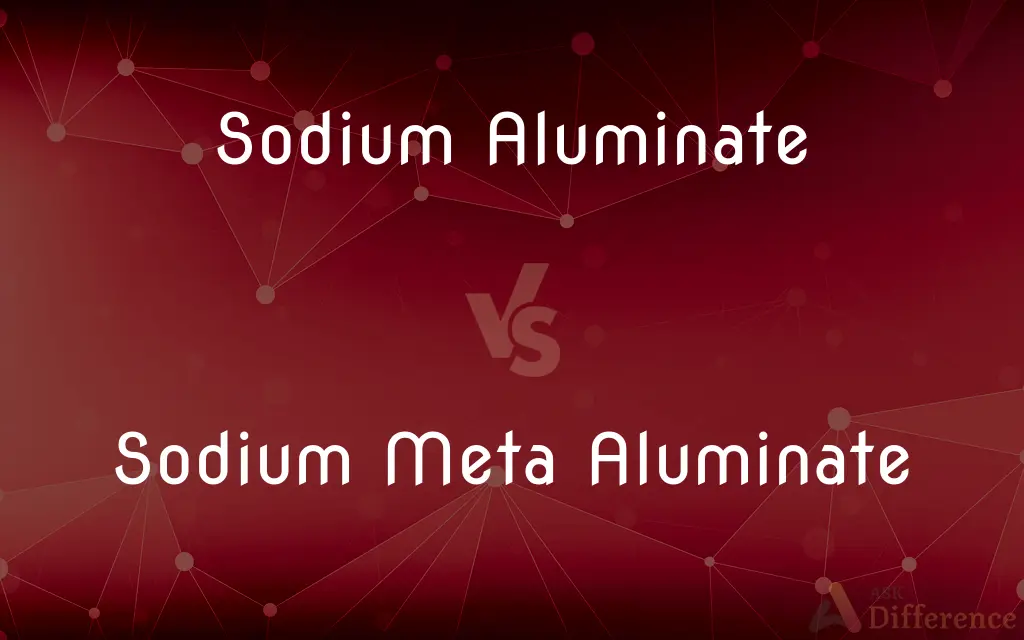Sodium Aluminate vs. Sodium Meta Aluminate — What's the Difference?
By Tayyaba Rehman & Fiza Rafique — Published on April 2, 2024
Sodium aluminate (NaAlO2) is used in water treatment and cement, showing basicity. Sodium meta aluminate, also NaAlO2, differs in structure and hydration, key for certain syntheses and industrial uses.

Difference Between Sodium Aluminate and Sodium Meta Aluminate
Table of Contents
ADVERTISEMENT
Key Differences
Sodium aluminate (NaAlO2) is a chemical compound that acts as a source of alumina in various industrial applications, including water treatment, where it helps in removing impurities and adjusting pH levels, and in the production of cement, where it accelerates setting time and improves strength. It is known for its basicity and ability to react with acids to form aluminum hydroxide precipitates, which can capture impurities.
Sodium meta aluminate, often represented with the same chemical formula NaAlO2, can be considered a specific structural form of sodium aluminate, with a distinction that lies in its synthesis process, crystalline structure, and reactivity, especially in how it interacts with water. In certain contexts, the term "meta" can denote a difference in hydration or a specific crystalline phase that has distinct reactivity, particularly in the synthesis of aluminates and related chemical processes.
The primary use of sodium aluminate in water treatment relies on its strong basicity and reactivity towards acidic components, leading to the precipitation of aluminum hydroxide, which aids in the coagulation and removal of suspended particles. On the other hand, sodium meta aluminate might be preferred in applications requiring specific reactivity patterns, such as in the synthesis of zeolites, where its unique crystalline structure and hydration properties can influence the formation and properties of the final product.
While both compounds are utilized in industrial processes for their alumina content and basic properties, the choice between sodium aluminate and sodium meta aluminate depends on the requirements of the specific application, such as the desired rate of reaction, the nature of the product being manufactured, or the specific conditions of the process, like temperature and pH.
Understanding the distinction between these compounds is crucial for chemists and engineers designing processes that involve aluminate chemistry. The specific properties of sodium meta aluminate, such as its hydration state and crystalline structure, can offer advantages in processes where control over reaction kinetics, product phase, and other properties are critical.
ADVERTISEMENT
Comparison Chart
Chemical Formula
NaAlO2
NaAlO2 (context-specific)
Structure
Amorphous or poorly crystalline
Specific crystalline structure
Reactivity with Water
Forms aluminum hydroxide precipitates
Different hydration properties
Use in Water Treatment
Commonly used for removing impurities
Less commonly used; specific applications
Industrial Applications
Water treatment, cement additive
Synthesis of zeolites, specific chemicals
Reactivity and Basicity
Highly reactive and basic
Reactivity and basicity depend on structure and hydration
Preferred Applications
General use in treating water, in cements
Applications requiring specific crystalline properties
Compare with Definitions
Sodium Aluminate
It is crucial in coagulation processes.
The water treatment facility uses sodium aluminate for coagulation.
Sodium Meta Aluminate
The compound can be tailored for specific industrial processes.
Adjusting the process conditions optimized sodium meta aluminate's effectiveness.
Sodium Aluminate
Sodium aluminate's basic nature allows it to neutralize acids.
Sodium aluminate was used to neutralize the acidic waste.
Sodium Meta Aluminate
It has unique hydration properties.
The hydration properties of sodium meta aluminate influence its reactivity.
Sodium Aluminate
Sodium aluminate can form aluminum hydroxide precipitates.
The reaction with sodium aluminate resulted in aluminum hydroxide.
Sodium Meta Aluminate
Sodium meta aluminate is used in specific chemical syntheses.
Sodium meta aluminate was a key reagent in synthesizing the zeolite.
Sodium Aluminate
It acts as a cement additive to improve properties.
Adding sodium aluminate to cement mixtures accelerates the setting time.
Sodium Meta Aluminate
It is involved in producing advanced materials.
Sodium meta aluminate is used in the production of advanced ceramic materials.
Sodium Aluminate
Sodium aluminate is used in water treatment to remove impurities.
Sodium aluminate was added to the water to precipitate out heavy metals.
Sodium Meta Aluminate
Sodium meta aluminate can offer specific crystalline benefits.
The crystalline structure of sodium meta aluminate was crucial for the reaction.
Common Curiosities
What does the term "meta" imply in sodium meta aluminate?
"Meta" often refers to a difference in hydration or a specific crystalline phase that affects the compound's reactivity and properties.
Can both compounds be used interchangeably in water treatment?
While both can be used in water treatment, sodium aluminate is more commonly employed due to its effectiveness in removing impurities and adjusting pH.
Why is the specific structure of sodium meta aluminate important?
Its specific crystalline structure can be crucial for applications requiring precise control over chemical reactions and product formation, such as in the synthesis of certain types of zeolites or advanced ceramics.
Can sodium aluminate and sodium meta aluminate be produced from the same raw materials?
Yes, both compounds can be synthesized from similar raw materials, typically involving a reaction between aluminum sources and sodium hydroxide, but the specific conditions and processes determine the final product's structure and properties.
What are the storage considerations for sodium aluminate and sodium meta aluminate?
Both compounds should be stored in a dry, cool place, away from incompatible substances. Sodium meta aluminate, due to its specific hydration properties, may require additional considerations to prevent unwanted reactions or degradation.
What is the main difference between sodium aluminate and sodium meta aluminate?
The main difference lies in their structure and specific hydration properties, influencing their industrial applications and reactivity.
How do the industrial applications of these compounds differ?
Sodium aluminate is broadly used in water treatment and as a cement additive, whereas sodium meta aluminate finds specialized use in chemical syntheses and the production of materials like zeolites.
How does the reactivity of sodium aluminate and sodium meta aluminate with water differ?
Sodium aluminate readily reacts with water to form aluminum hydroxide precipitates, useful in coagulation processes. Sodium meta aluminate's reactivity with water is influenced by its specific hydration properties, affecting how it is used in certain reactions and syntheses.
Why might a manufacturer choose sodium meta aluminate over sodium aluminate for specific applications?
A manufacturer might choose sodium meta aluminate for its unique crystalline structure and hydration properties, which can be advantageous in specific chemical syntheses, such as producing zeolites or other materials where these properties influence the outcome.
Can sodium aluminate affect the taste of treated water?
While sodium aluminate is used to improve water quality, if not properly managed, it can affect the water's taste due to changes in pH or residual aluminum compounds. Water treatment processes are designed to minimize such impacts.
Are sodium aluminate and sodium meta aluminate considered safe for environmental applications?
Both compounds, when used appropriately, are considered safe for environmental applications such as water treatment. However, like all chemicals, their handling and disposal must comply with environmental regulations to avoid potential impacts.
What role does pH play in the use of sodium aluminate in water treatment?
The effectiveness of sodium aluminate in water treatment is pH-dependent; its basic nature helps in adjusting the pH of the water upwards, which is crucial for the precipitation and removal of certain impurities.
How does the choice between sodium aluminate and sodium meta aluminate affect the cost of industrial processes?
The choice can affect process costs differently; sodium aluminate is widely available and used, potentially making it more cost-effective for general applications. Sodium meta aluminate might be preferred for specialized applications but could come at a higher cost due to its specific production process and properties.
What advancements in technology could influence the future use of sodium aluminate and sodium meta aluminate?
Advances in material science and chemical engineering could lead to new applications for these compounds, such as more efficient water treatment technologies or innovative materials. Additionally, improvements in production methods could enhance their environmental sustainability and cost-effectiveness.
How do environmental regulations impact the use of sodium aluminate and sodium meta aluminate in industrial applications?
Environmental regulations require that the use of these compounds does not adversely affect the environment or human health. This includes limits on residual concentrations in discharged water and guidelines on safe handling and disposal.
Share Your Discovery

Previous Comparison
Knee Brace vs. Knee Immobilizer
Next Comparison
Labrador vs. Golden RetrieverAuthor Spotlight
Written by
Tayyaba RehmanTayyaba Rehman is a distinguished writer, currently serving as a primary contributor to askdifference.com. As a researcher in semantics and etymology, Tayyaba's passion for the complexity of languages and their distinctions has found a perfect home on the platform. Tayyaba delves into the intricacies of language, distinguishing between commonly confused words and phrases, thereby providing clarity for readers worldwide.
Co-written by
Fiza RafiqueFiza Rafique is a skilled content writer at AskDifference.com, where she meticulously refines and enhances written pieces. Drawing from her vast editorial expertise, Fiza ensures clarity, accuracy, and precision in every article. Passionate about language, she continually seeks to elevate the quality of content for readers worldwide.
















































